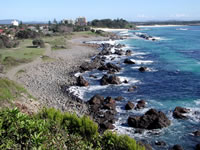|
|||||||||||||||||||||||
| School of Biological, Earth & Environ Sciences | |||||||||||||||||||||||

School Website Overview The School of Biological Earth and Environmental Sciences (BEES) was formed in January 2002 from the previously existing School of Biological Science, School of Geology and the Physical Geographers. While the School of Biological, Earth & Enviromental Sciences denotes a single entity, the school maintains the programs offered by the former disciplines. Thus, students can study pure Biological Science, Geology or Geography, while new BEES courses make interdisciplinary study much easier.
The School now has 30 academic staff, 20 postdoctoral research staff, about 70 research students and about 75 Honours students. It offers a wide range of undergraduate and postgraduate programs. Honours programs are currently available in biological science, botany, zoology, ecology, environmental science, geography and geology. The School of Biological, Earth and Environmental Sciences has an outstanding reputation for quality research both within Australia and internationally. BEES attracts over $2.5 M in external research finding, both via competitive funding from the Australian Research Council and a diversity of additional sources of basic and applied funding. Research within BEES is clustered within two general thematic areas: Ecology and Evolutionary Biology and Environmental Change and Sustainability. Within these two themes there are four focal points for research:
Other areas of research interest within the School include resource management and a diversity of interests within the biological and earth sciences.
Field stations are maintained for teaching and field research at Smiths Lake and for research and animal holding/breeding at Cowan. The School also makes extensive use of the University's Arid Zone field station in at Fowlers Gap in north western New South Wales. For further information on the programs of study offered by the School, please refer to the relevant discipline entries in this online Handbook and to the School's website. We look forward to welcoming you to UNSW.
Undergraduate Specialisations
Postgraduate Specialisations
Research Specialisations
|
|||||||||||||||||||||||



